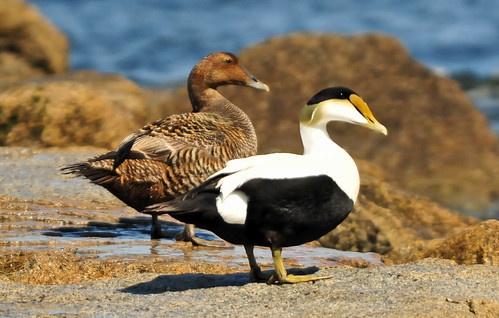冰島科學家和美國地質調查局(USGS)在冰島發現源自北美和歐洲的禽流感帶原候鳥,顯示北大西洋地區是禽流感在歐洲和北美之間傳播的路徑;和北太平洋一樣,北大西洋是禽流感的大熔爐。此外,USGS另一個研究團隊還發現,海獺也會感染人類的流感。
歐洲、北美候鳥遷徙路徑 冰島是最大中繼站
「我們發現的這些禽流感病毒對人類無害,但可見冰島是研究禽流感的重要地點,值得多加留意和監控。」研究主持人、USGS科學家Robert Dusek說。
不少來自歐洲和北美的候鳥,遷徙途中在冰島的溼地匯集,感染的候鳥在此將病毒傳染給健康候鳥,再分別把病毒帶往歐洲和北美。禽流感便是循此路徑從歐洲傳播到美國。而候鳥在冰島的匯集也導致新的病毒演化形成。
這些發現對於監控流感病毒非常重要,包括能禽傳人的H5N1。
海鷗是重要媒介 學者定序出混種病毒
這項3月19日發表於「PLOS ONE」期刊的研究也首次發現,海鷗是禽流感病毒跨越北大西洋地區傳播的重要媒介。
2003年底、2004年初,H5N1禽流感爆發於亞洲,造成數百萬隻的雞鴨死亡或被撲殺。Dusek和研究團隊在冰島野外捕捉海鷗和水鳥,從中隔離並完整定序了29個禽流感病毒的基因組,發現有純美裔、純歐亞裔和美歐亞混種的病毒。
「病毒不斷在演化,而不同病毒株交雜混和的環境,是發展新型禽流感的溫床。」研究主要調查員、USGS共同作者Jeffrey Hall說。
人類流感能傳染給海獺
過去曾發現鴨、雞、豬、鯨魚、馬和象感染流感的病例,此研究首次發現海獺感染的證據。
USGS另一個科學團隊在北美太平洋沿岸、華盛頓州水域發現,有海獺感染了2009年造成全球大流行的人類流感H1N1病毒。
研究人員採集此處海獺的血液樣本,發現有高達70%的樣本有2009年H1N1病毒的抗體。這些海獺並沒有可見的病徵,但是抗體的存在表示海獺曾經接觸過流感病毒。
「我們不確定海獺是如何感染H1N1的。這群海獺生活的地區相對偏遠,也很少和人類接觸。」CDC科學家、研究主要作者Zhunan Li說。
The North Atlantic region is a pathway for bird flu to move between Europe and North America, U.S. Geological Survey scientists and their Icelandic partners have discovered. Across the world, a separate team of USGS scientists found sea otters infected with human influenza.
USGS and Icelandic scientists found avian influenza viruses originating from both North America and Europe in migratory birds in Iceland, demonstrating that the North Atlantic is as important as the North Pacific as a melting pot for birds and avian flu.
“None of the avian flu viruses found in our study are considered harmful to humans,” said Robert Dusek, USGS scientist and lead author of the study. “However, the results suggest that Iceland is an important location for the study of avian flu and is worthy of special attention and monitoring.”
A great number of wild birds from Europe and North America congregate and mix in Iceland’s wetlands during migration, where infected birds could transmit avian flu viruses to healthy birds from either location.
By crossing the Atlantic Ocean this way, avian flu viruses from Europe could eventually be transported to the United States.
This commingling could also lead to the evolution of new influenza viruses.
These findings are critical for proper surveillance and monitoring of flu viruses, including the H5N1 avian influenza that can infect humans.
Published March 19 in the journal “PLOS ONE,” the study demonstrated for the first time that gulls play an important role in moving avian flu viruses across the North Atlantic.
H5N1 is the original avian influenza that broke out in Asia in late 2003 and early 2004, killing and causing the culling of millions of chickens and ducks. Dusek and his team isolated and fully sequenced the genomes of 29 avian influenza viruses from wild caught gulls and waterfowl in Iceland.
The scientists detected viruses that were entirely of American lineage, viruses that were entirely of Eurasian lineage, and viruses with mixed American-Eurasian lineage.
“Viruses are continually evolving, and this mixing of viral strains sets the stage for new types of avian flu to develop,” said Jeffrey Hall, USGS co-author and principal investigator on this study.
Human Flu Can Infect Sea Otters
In a separate flu study by USGS scientists on the Pacific coast of North America, sea otters living in the waters of Washington State were found to be infected with the same H1N1 flu virus that infected humans in 2009, causing a world-wide pandemic.
The researchers discovered antibodies for the 2009 H1N1 flu virus in blood samples from 70 percent of the sea otters studied.
None of the otters were visibly sick, but the presence of antibodies means that the otters were previously exposed to influenza.
“We are unsure how these animals became infected,” said Zhunan Li, CDC scientist and lead author on the paper. “This population of sea otters lives in a relatively remote environment and rarely comes into contact with humans.”
This study is the first time that evidence of influenza infection has been detected in sea otters, although these viruses have been found in many different animals, including ducks, chickens, pigs, whales, horses and elephant seals.
※ 全文及圖片詳見:ENS




